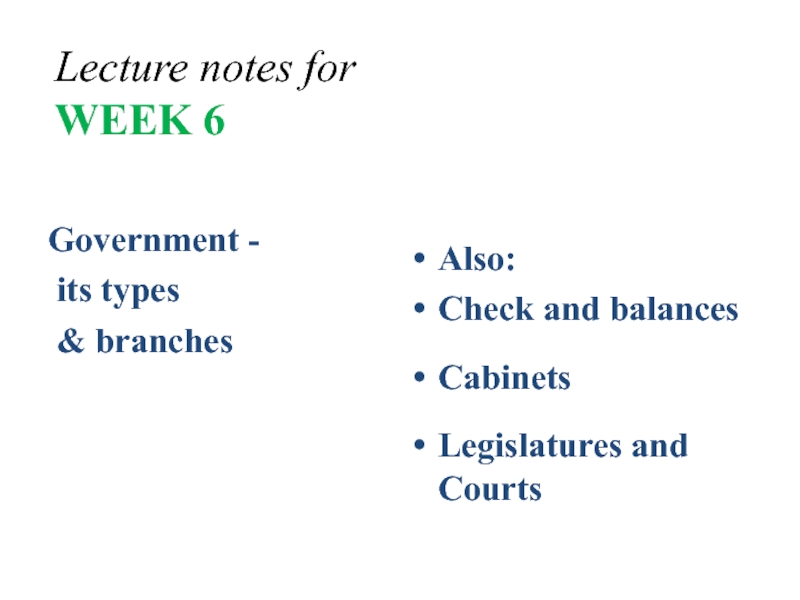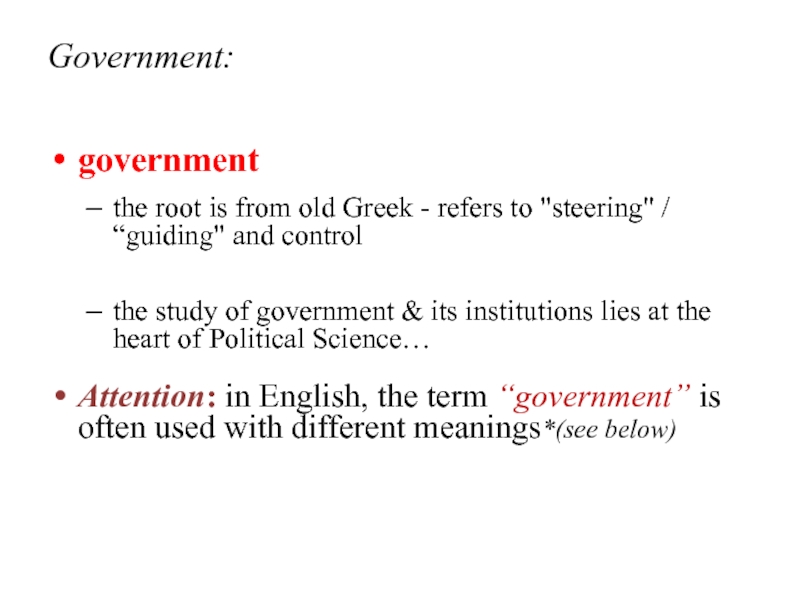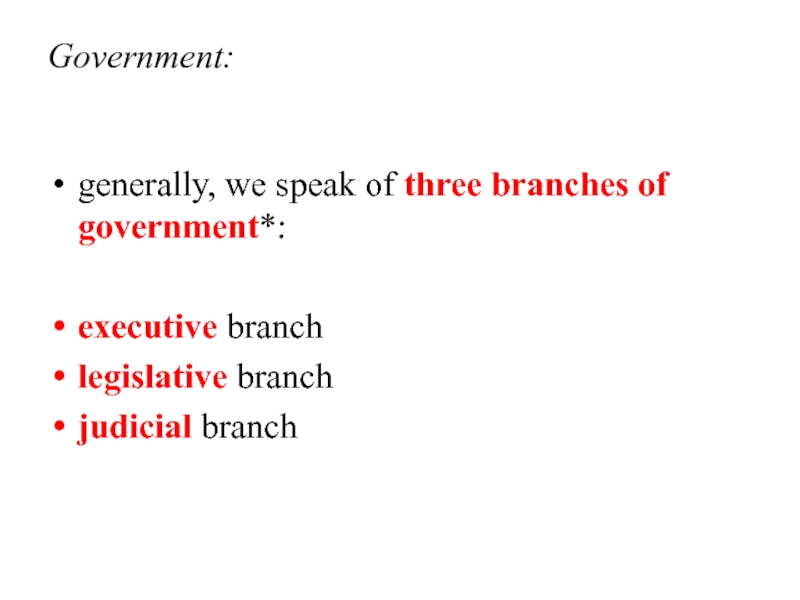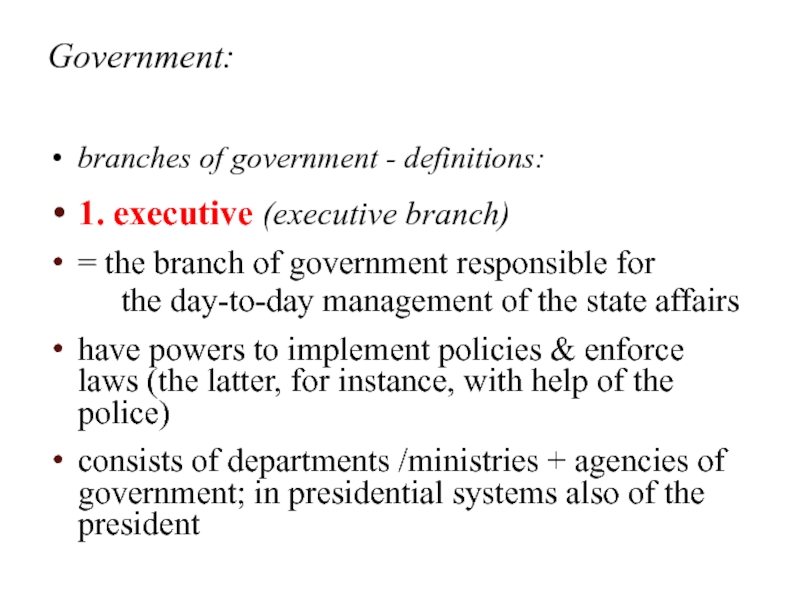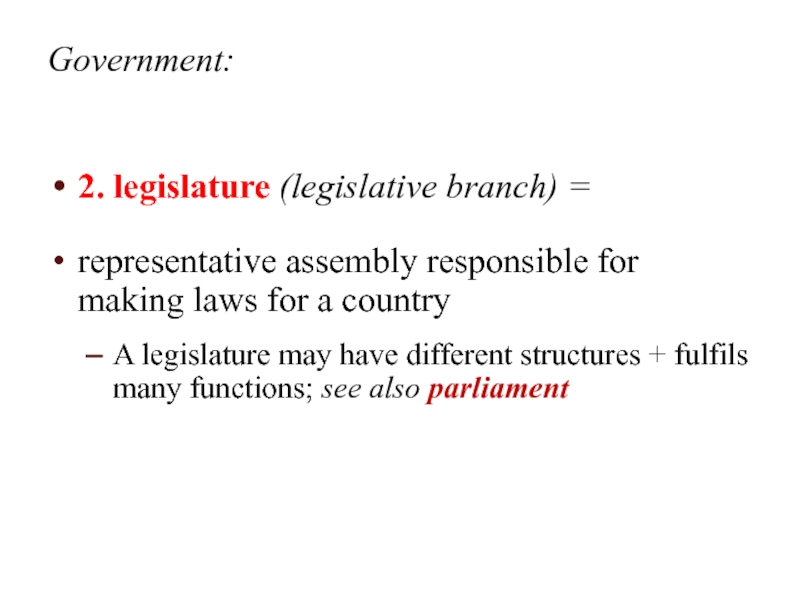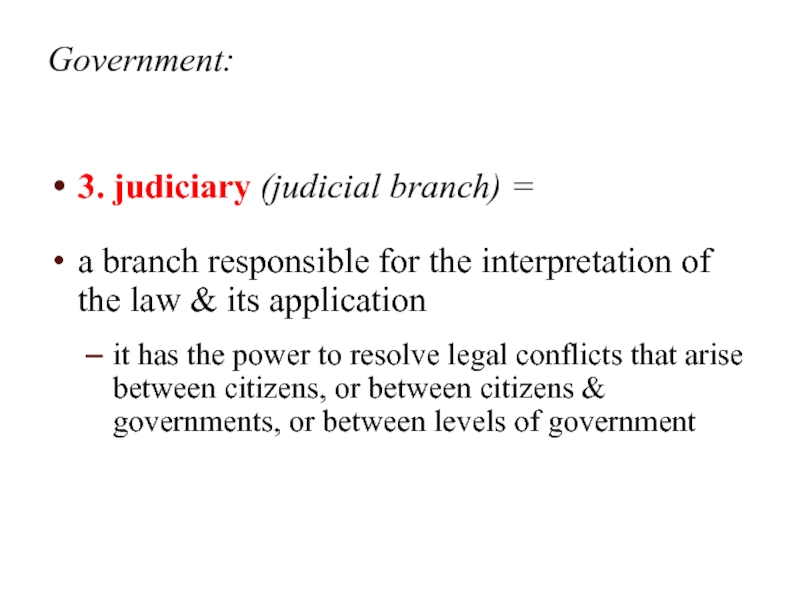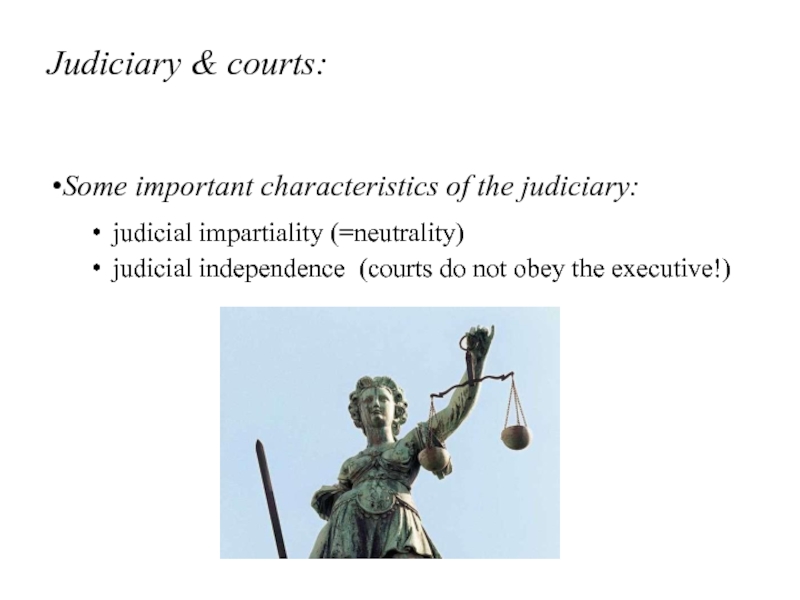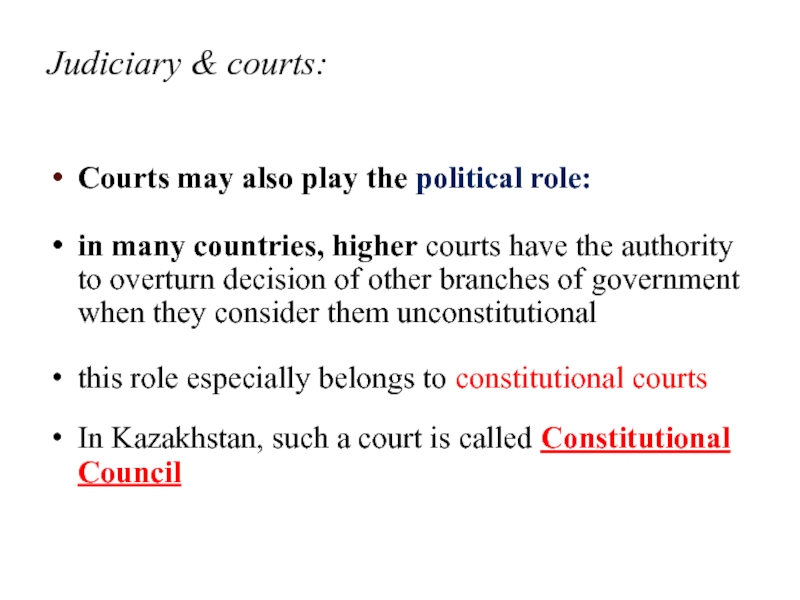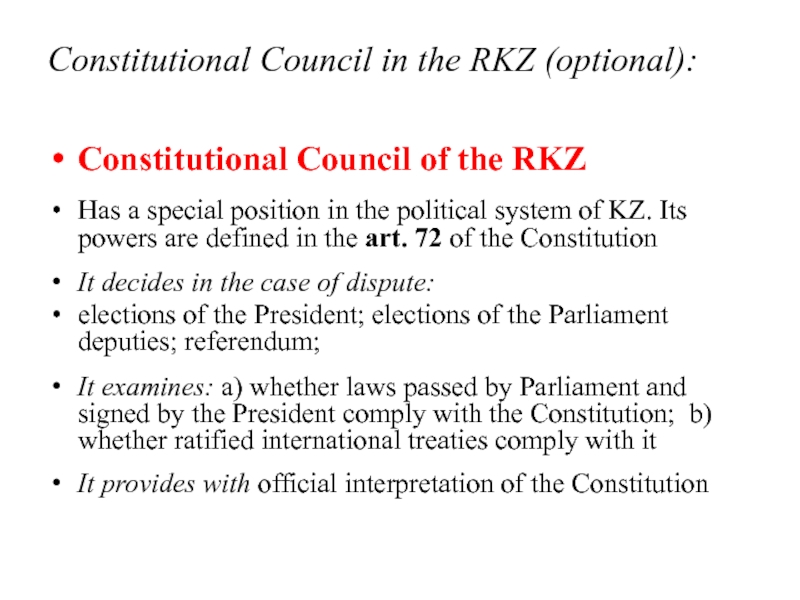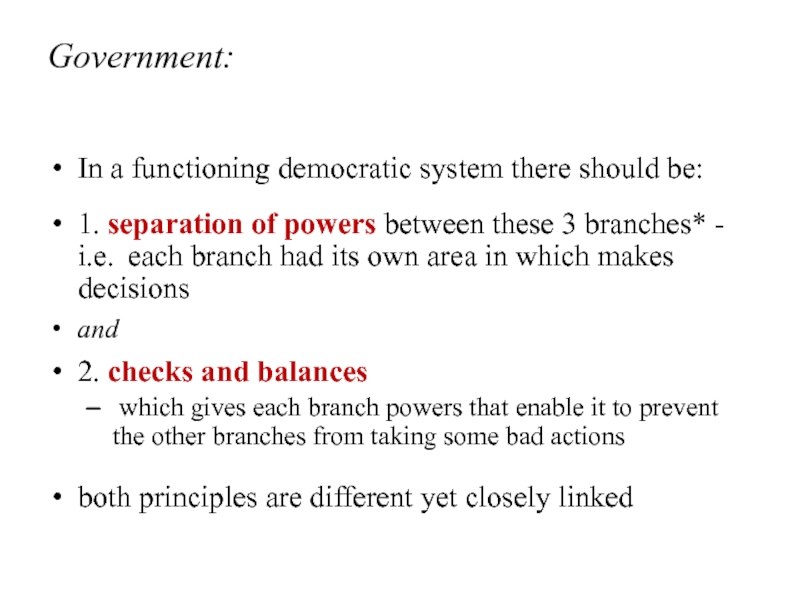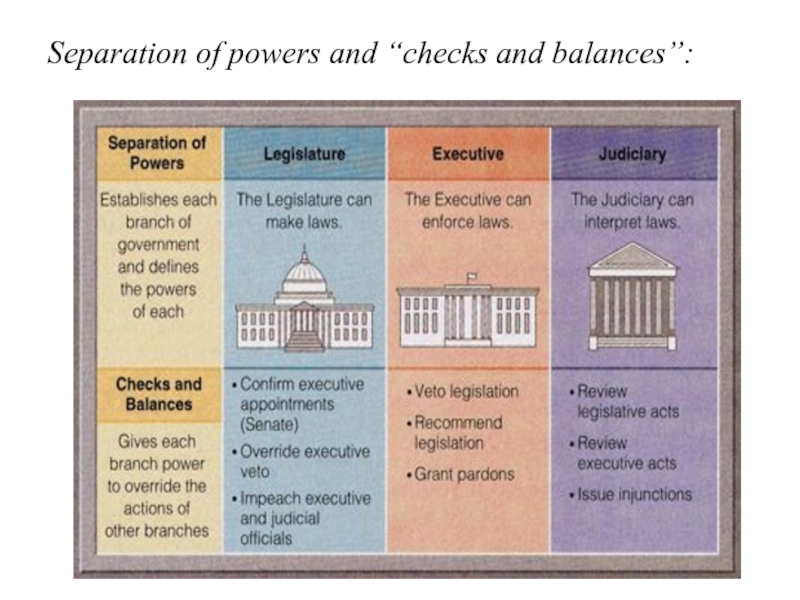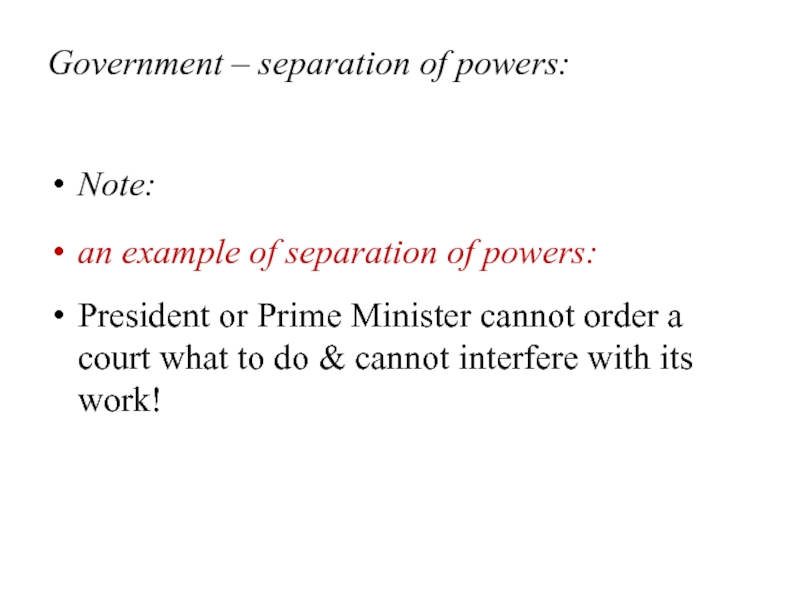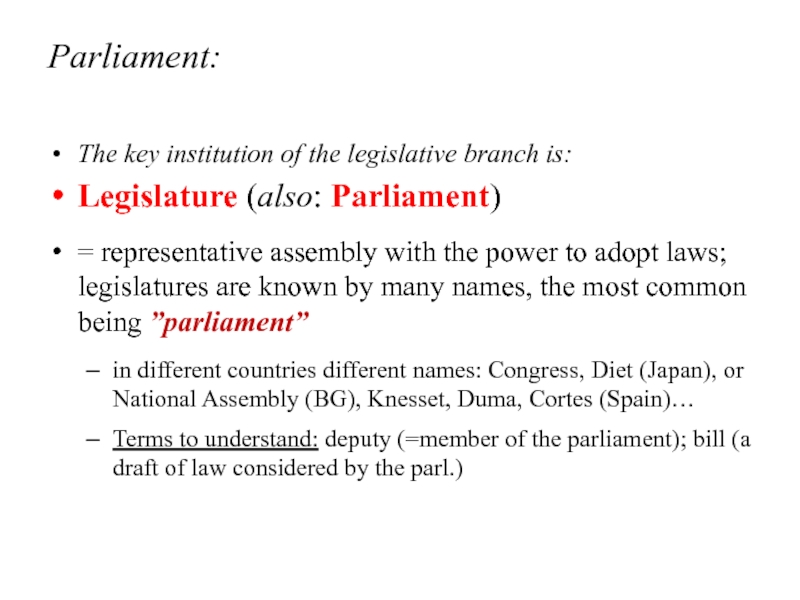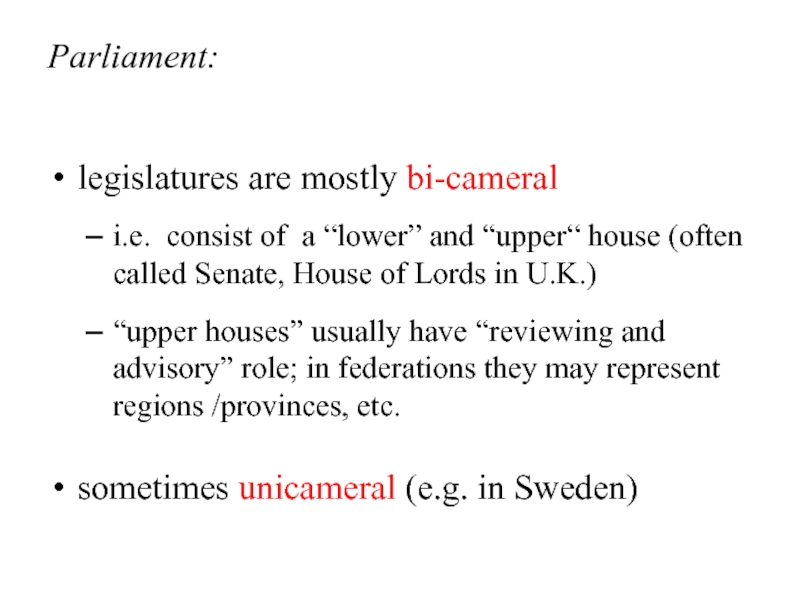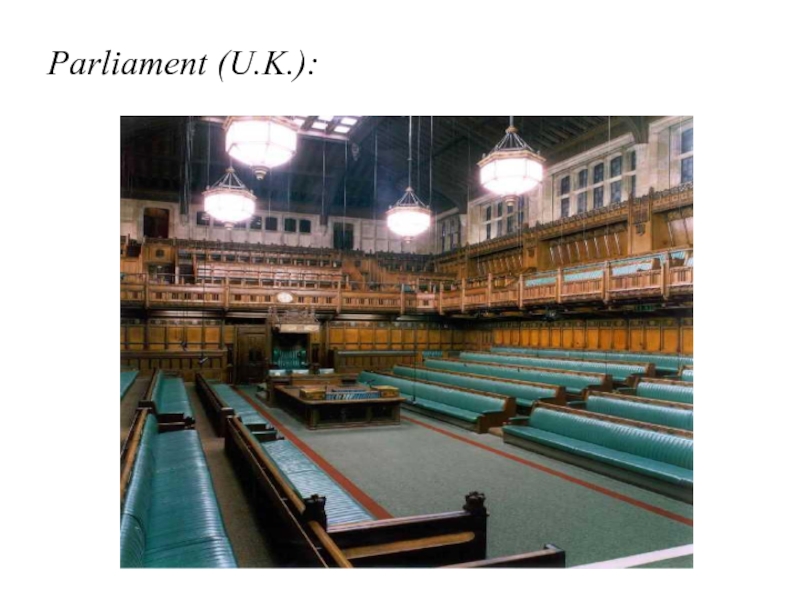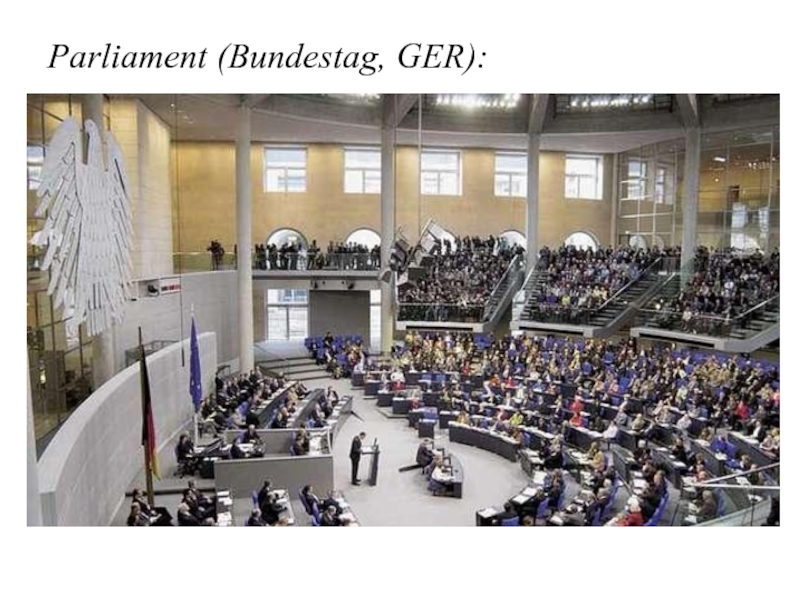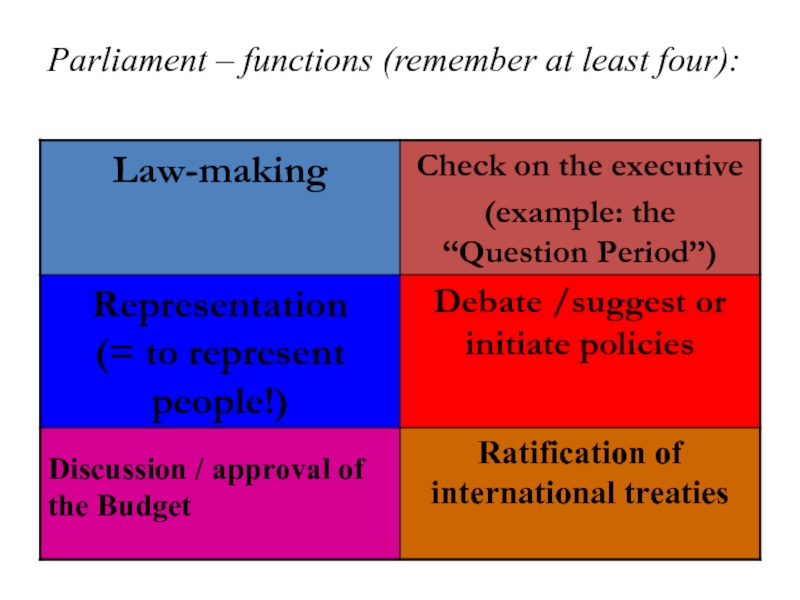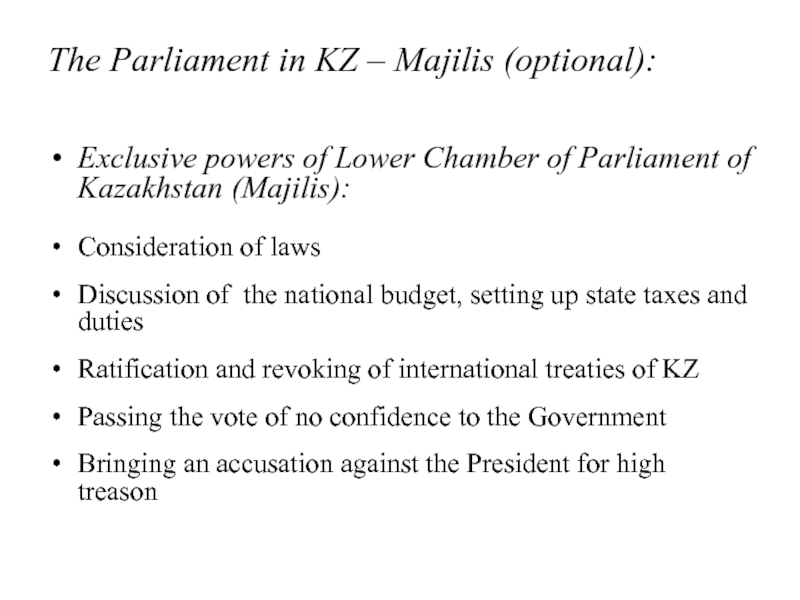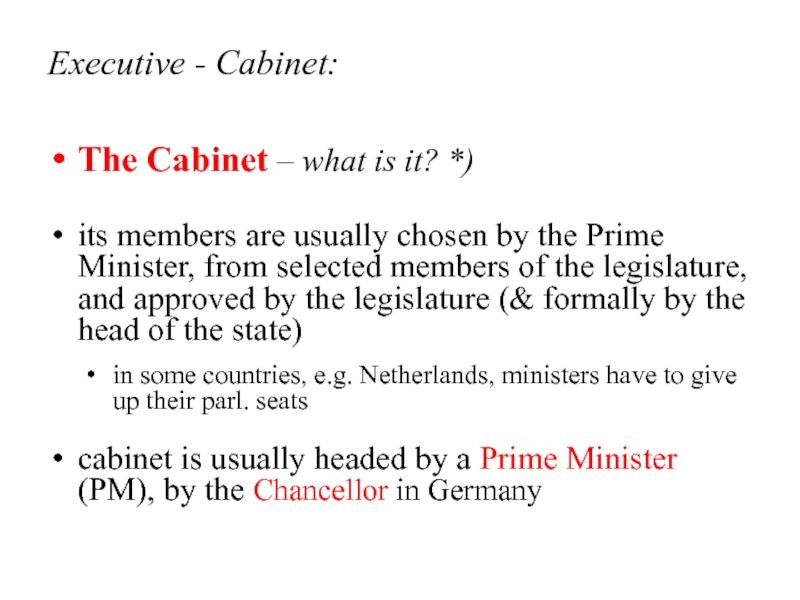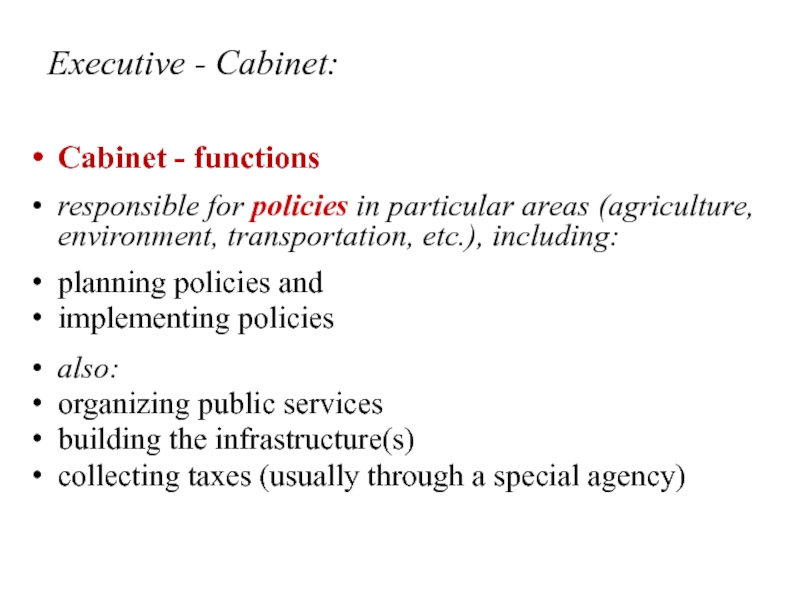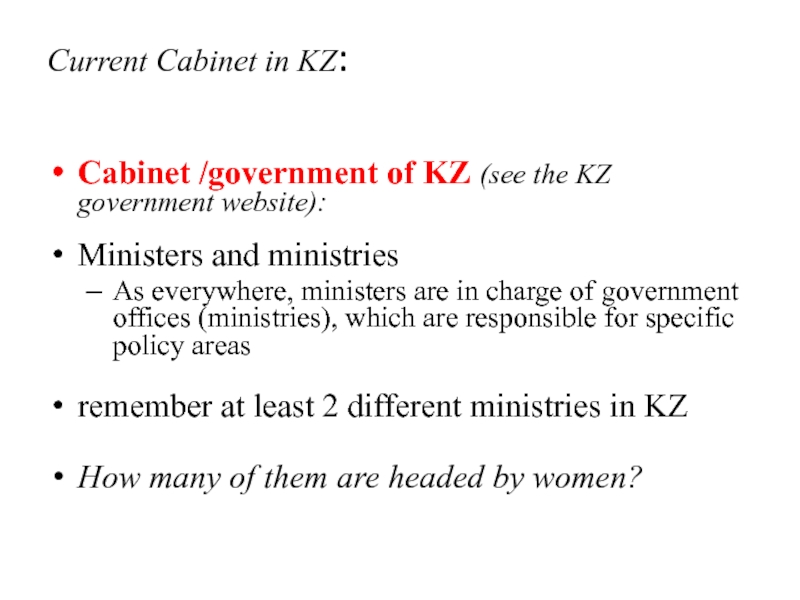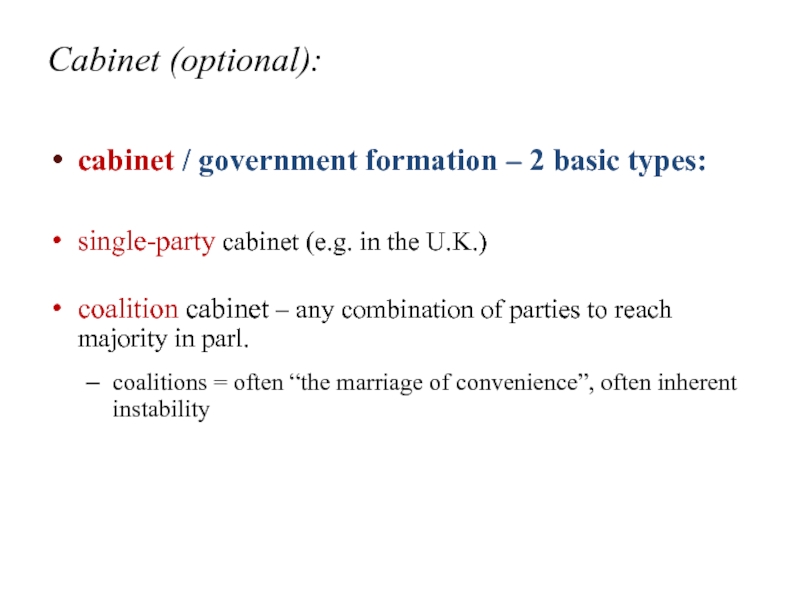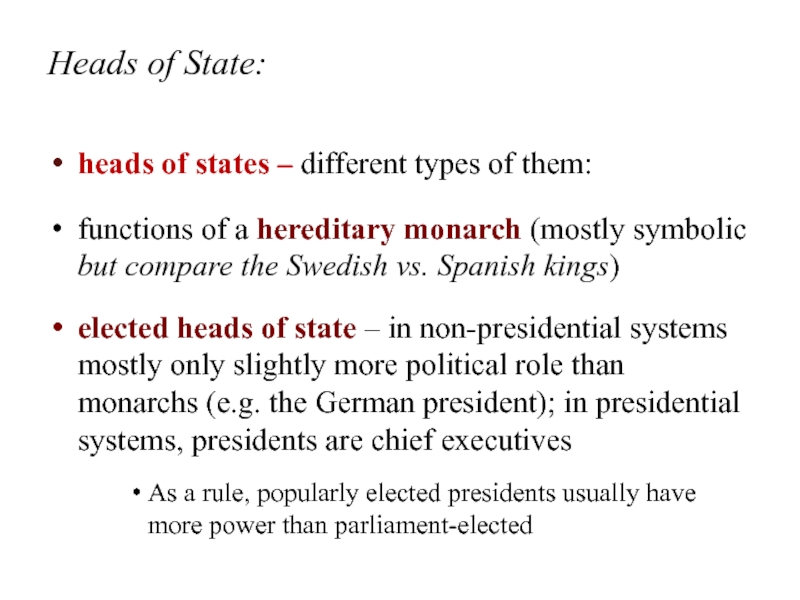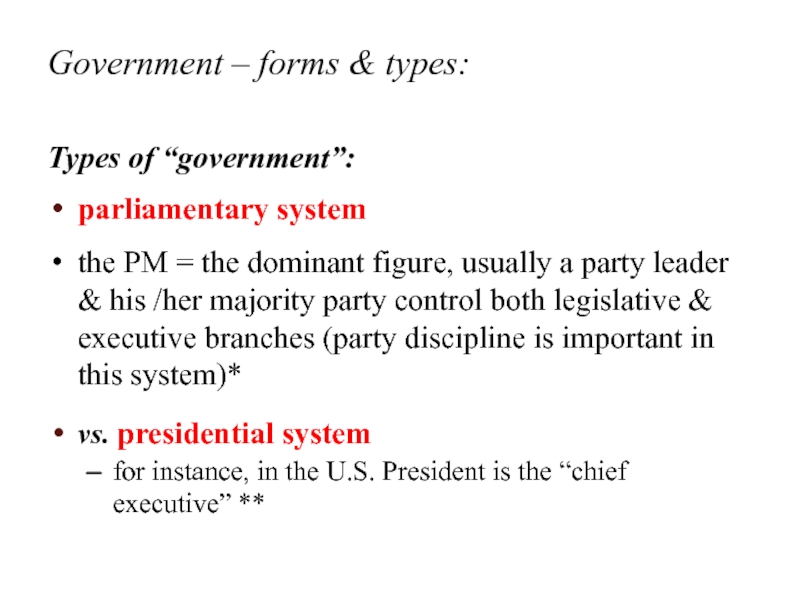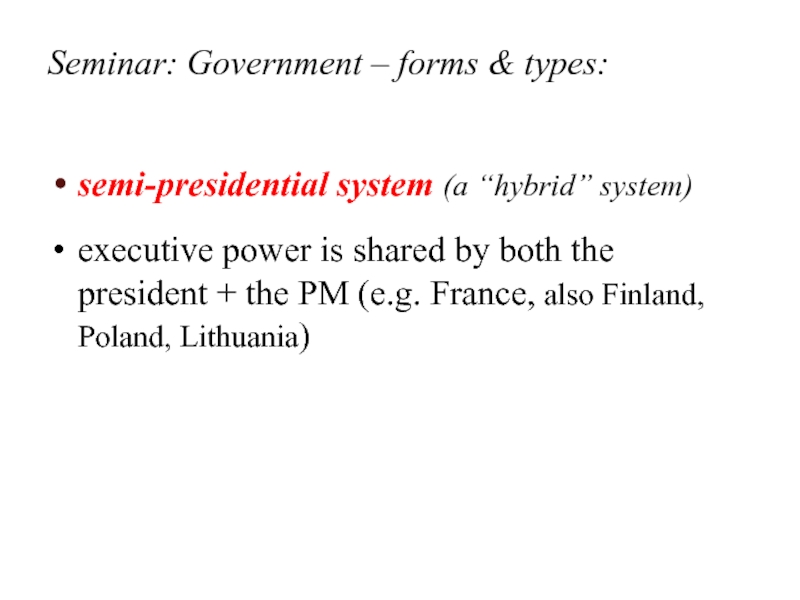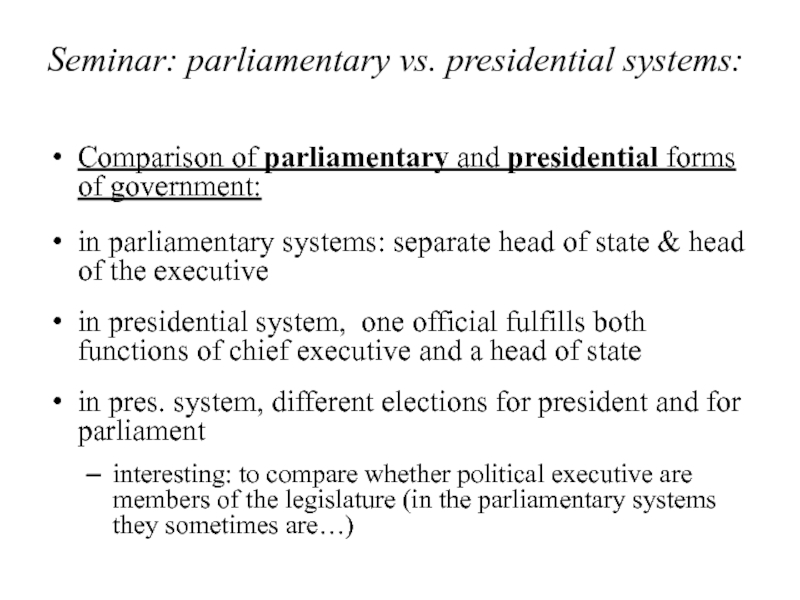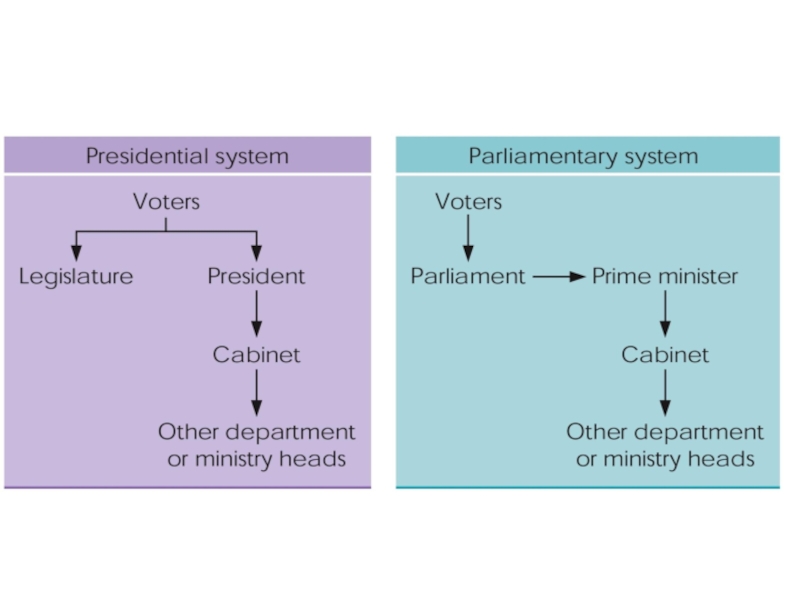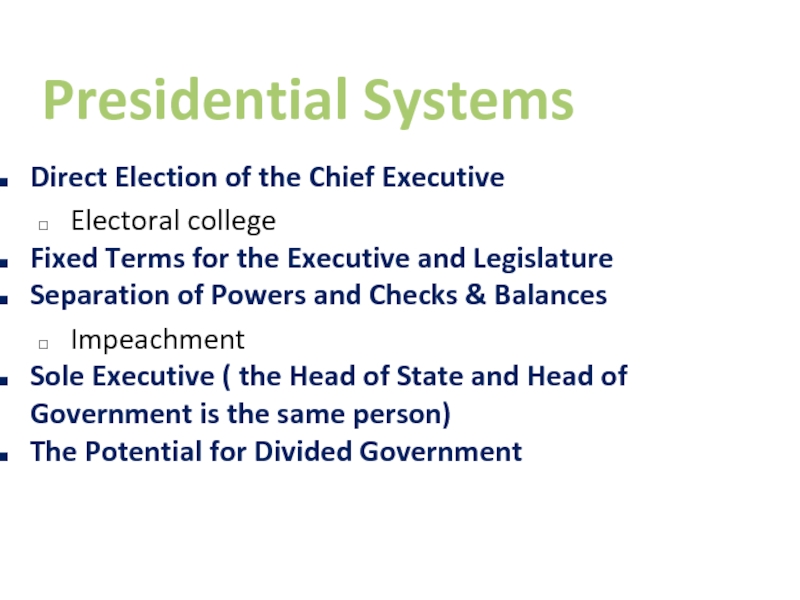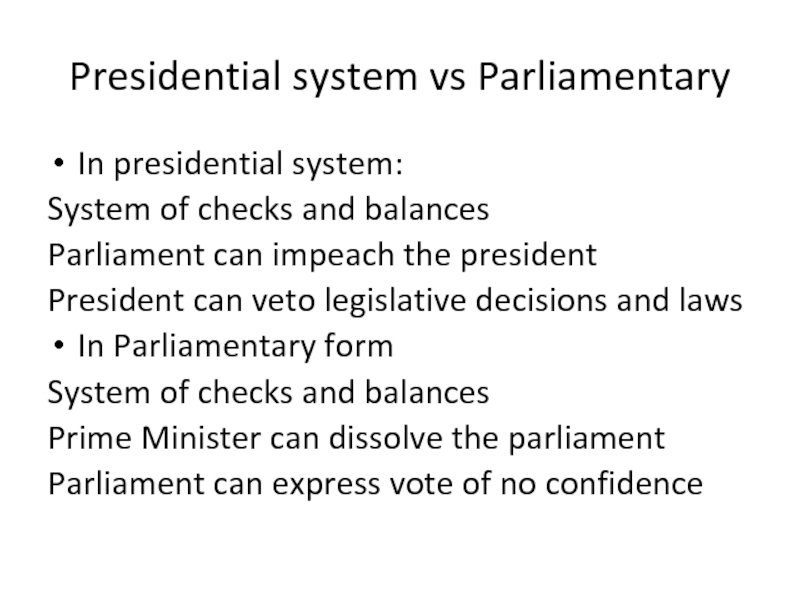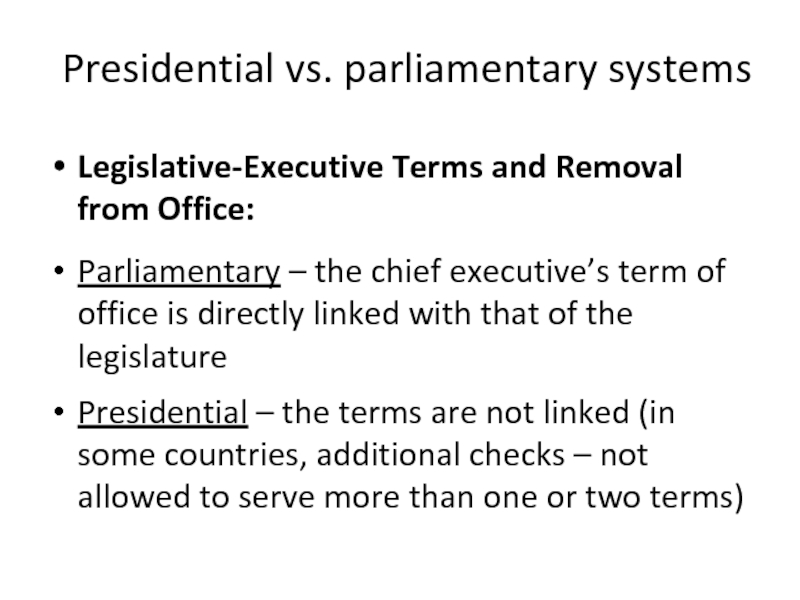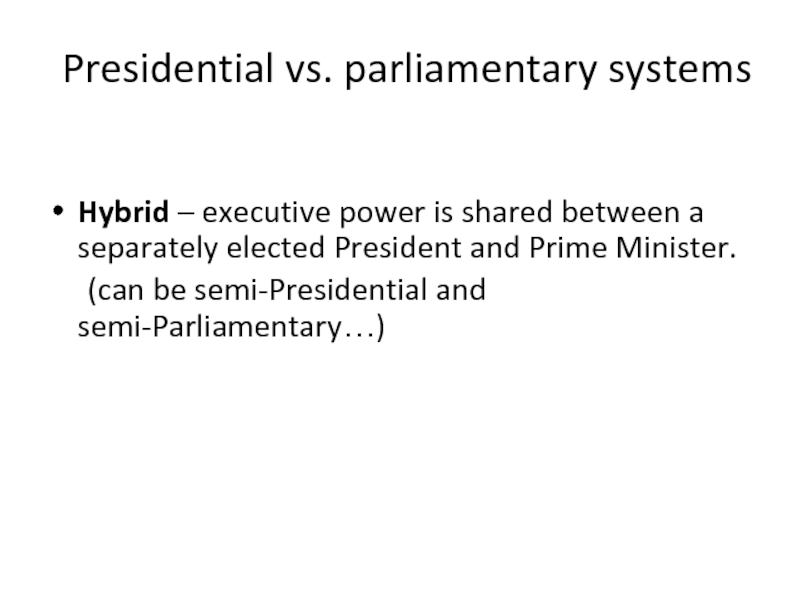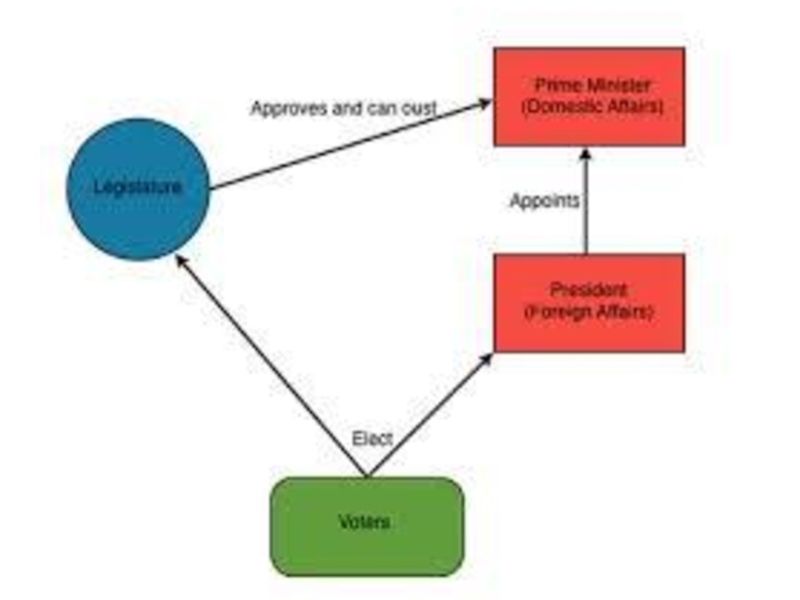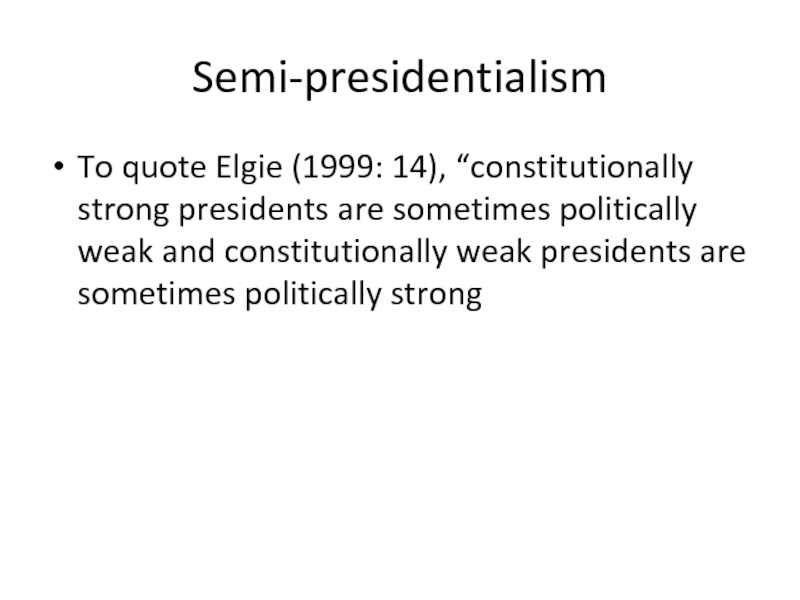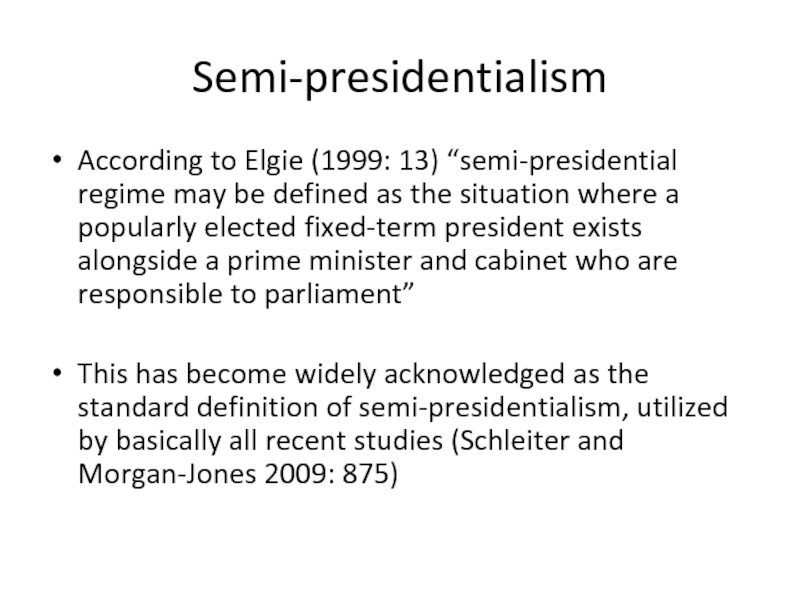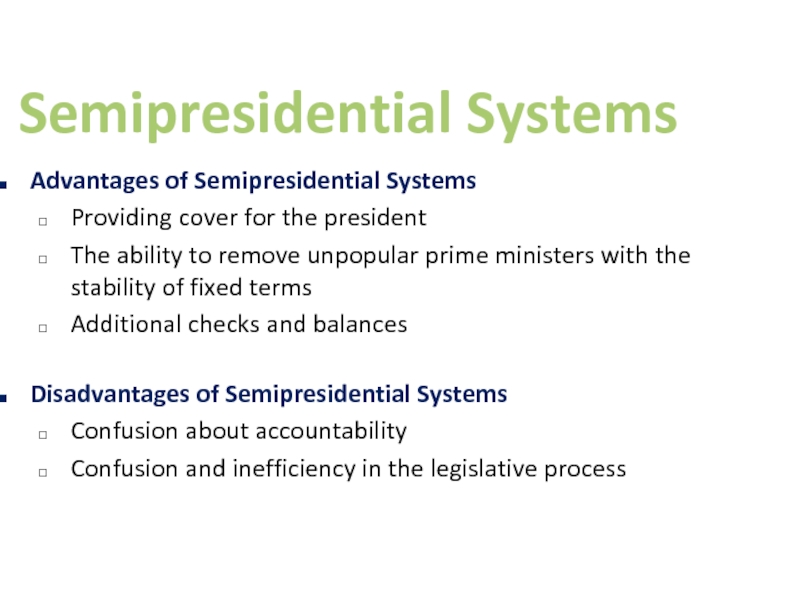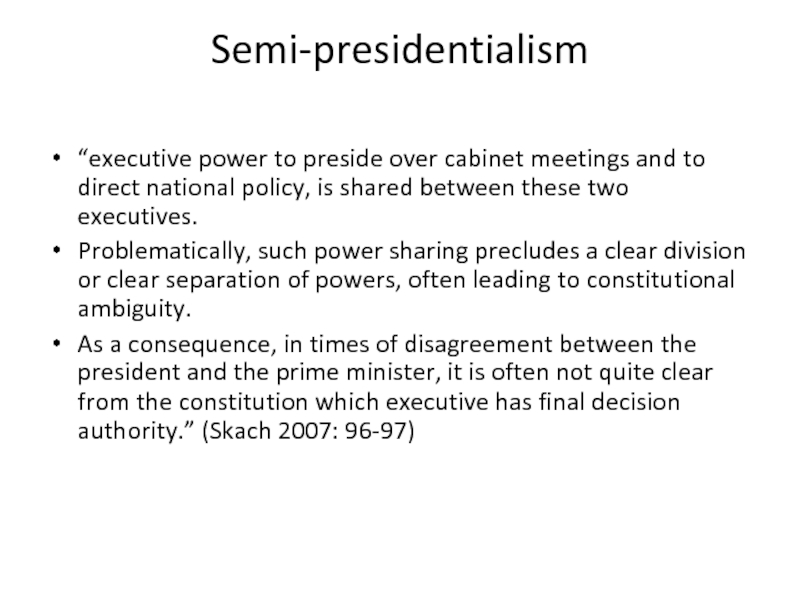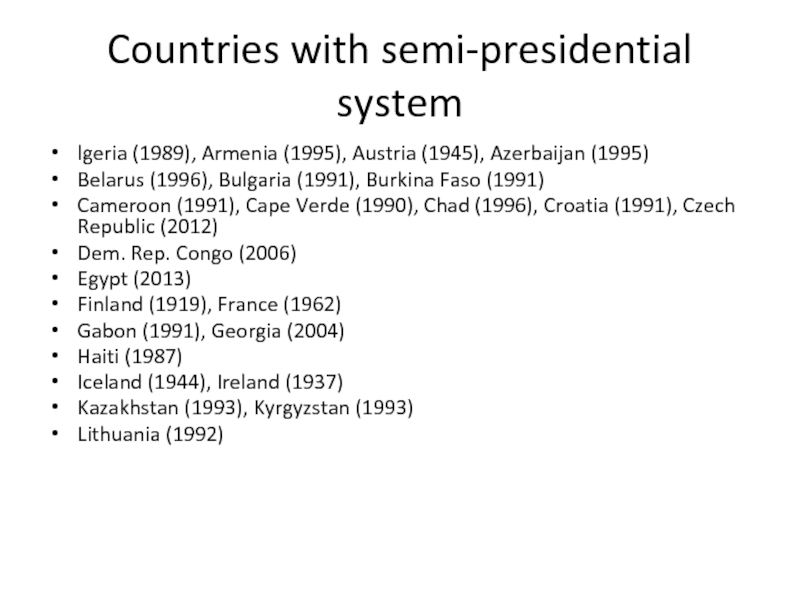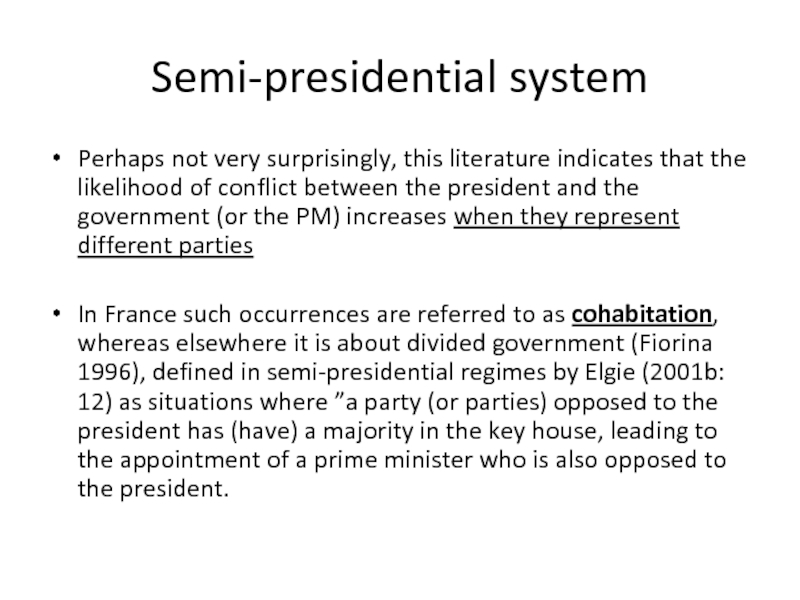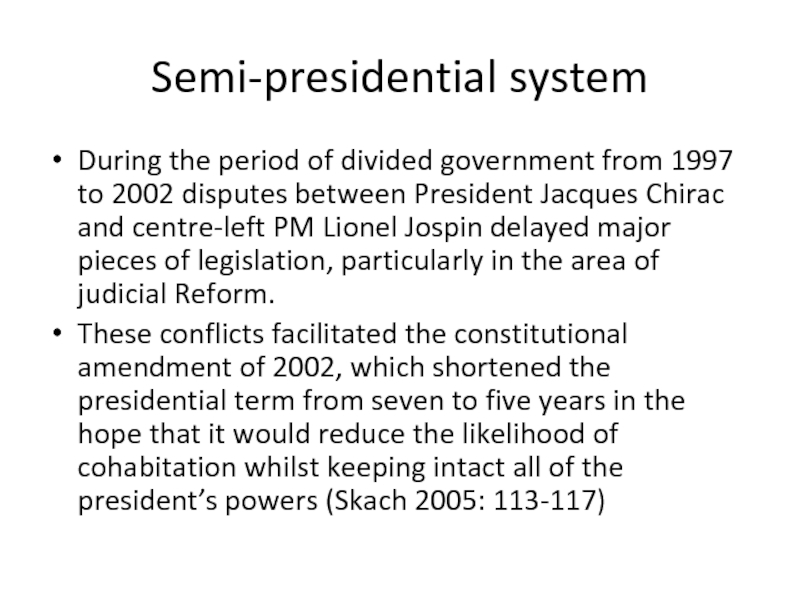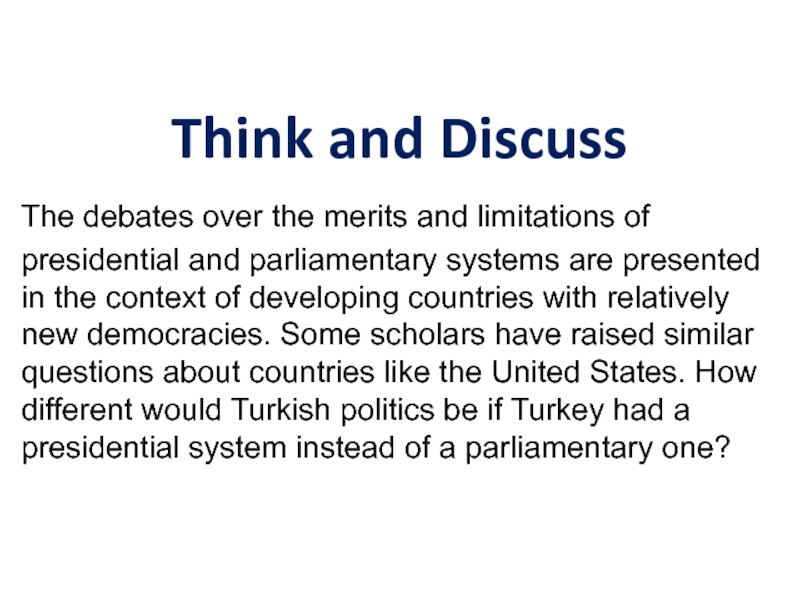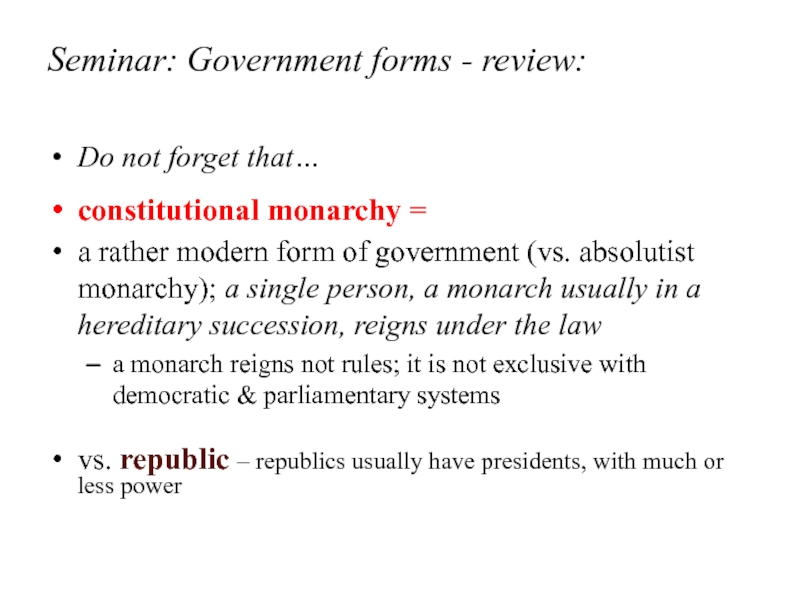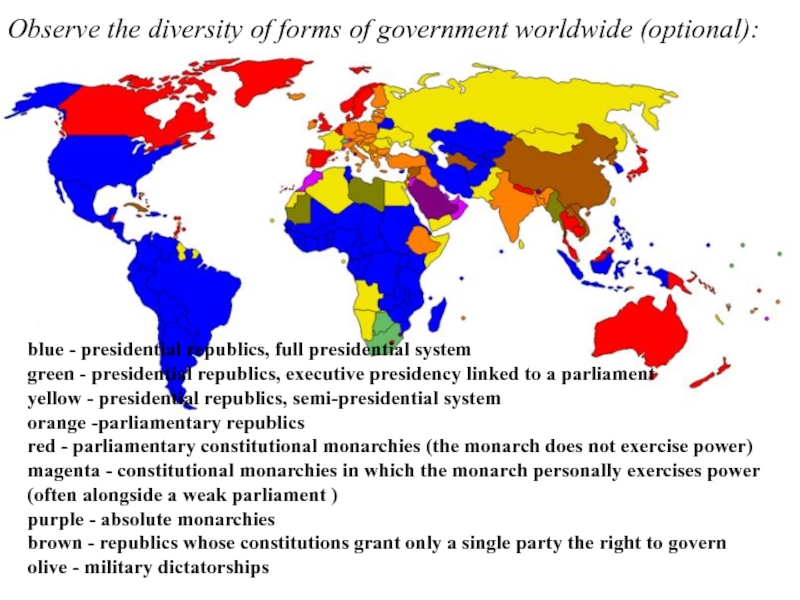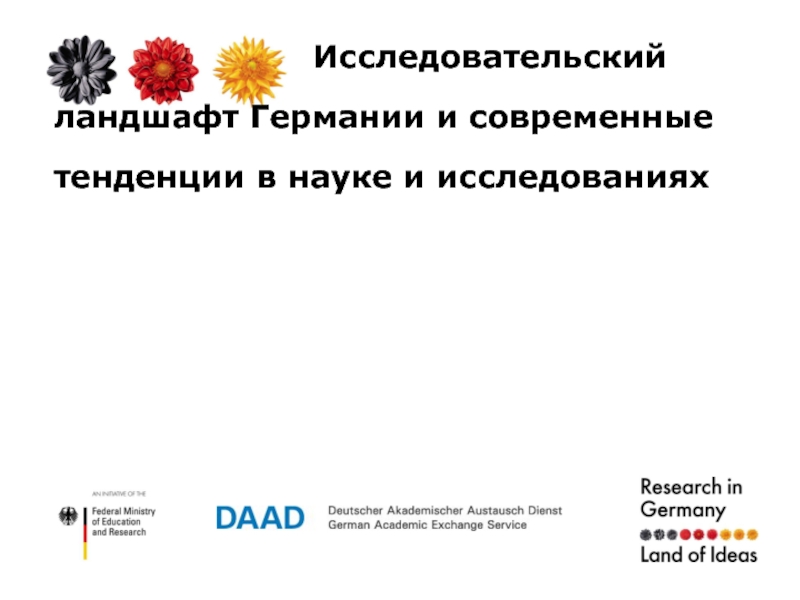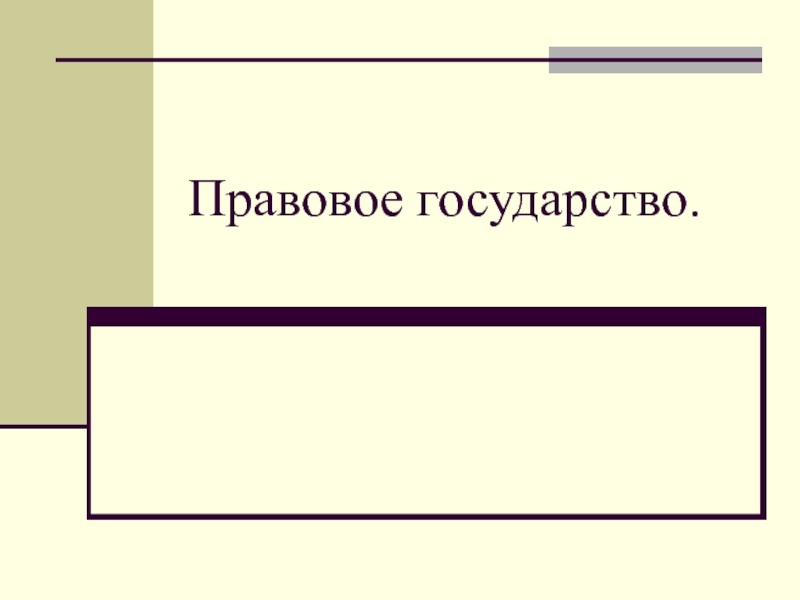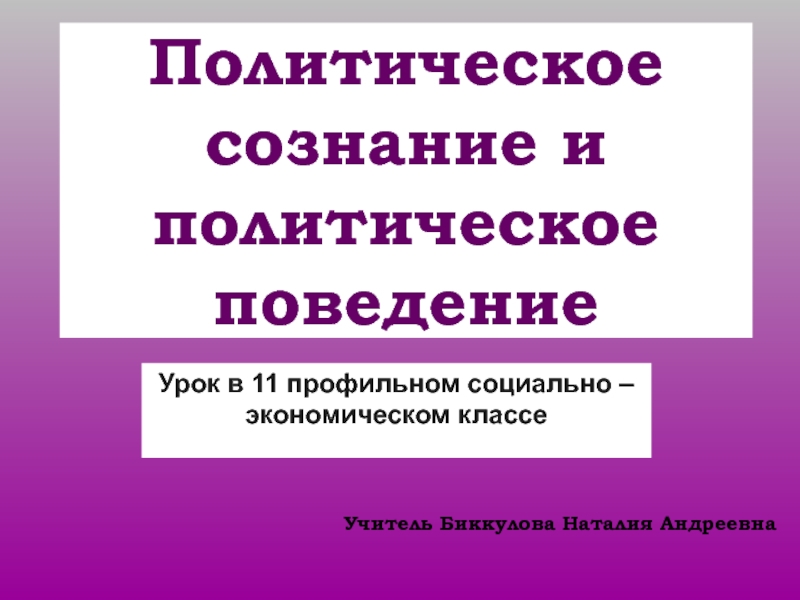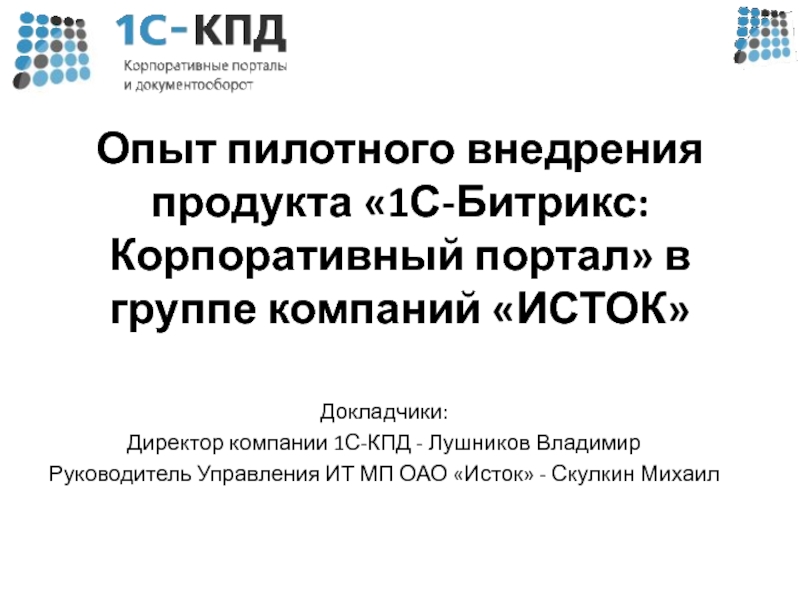- Главная
- Разное
- Дизайн
- Бизнес и предпринимательство
- Аналитика
- Образование
- Развлечения
- Красота и здоровье
- Финансы
- Государство
- Путешествия
- Спорт
- Недвижимость
- Армия
- Графика
- Культурология
- Еда и кулинария
- Лингвистика
- Английский язык
- Астрономия
- Алгебра
- Биология
- География
- Детские презентации
- Информатика
- История
- Литература
- Маркетинг
- Математика
- Медицина
- Менеджмент
- Музыка
- МХК
- Немецкий язык
- ОБЖ
- Обществознание
- Окружающий мир
- Педагогика
- Русский язык
- Технология
- Физика
- Философия
- Химия
- Шаблоны, картинки для презентаций
- Экология
- Экономика
- Юриспруденция
Government its types & branches. (Week 6) презентация
Содержание
- 1. Government its types & branches. (Week 6)
- 2. Government: government the root is from
- 3. Government: generally, we speak of three
- 4. Government: branches of government - definitions:
- 5. Government: 2. legislature (legislative branch) =
- 6. Government: 3. judiciary (judicial branch) =
- 7. Judiciary & courts: Some important characteristics
- 8. Judiciary & courts: Courts may also
- 9. Constitutional Council in the RKZ (optional): Constitutional
- 10. Government: In a functioning democratic system
- 11. Separation of powers and “checks and balances”:
- 12. Government – separation of powers: Note:
- 13. Parliament: The key institution of
- 14. Parliament: legislatures are mostly bi-cameral
- 15. Parliament (U.K.):
- 16. Parliament (Bundestag, GER):
- 17. Parliament – functions (remember at least four):
- 18. The Parliament in KZ – Majilis (optional):
- 19. Executive - Cabinet: The Cabinet – what
- 20. Executive - Cabinet: Cabinet - functions
- 21. Current Cabinet in KZ: Cabinet /government
- 22. Cabinet (optional): cabinet / government formation –
- 23. Heads of State: heads of states –
- 24. Government – forms & types: Types of
- 25. Seminar: Government – forms & types:
- 26. Seminar: parliamentary vs. presidential systems: Comparison of
- 28. Presidential Systems Direct Election of the Chief
- 29. Presidential system vs Parliamentary In presidential system:
- 30. Presidential vs. parliamentary systems Legislative-Executive Terms and
- 31. Presidential vs. parliamentary systems Hybrid
- 33. Semi-presidentialism To quote Elgie (1999: 14), “constitutionally
- 34. Semi-presidentialism According to Elgie (1999: 13) “semi-presidential
- 35. Semipresidential Systems Advantages of Semipresidential Systems Providing
- 36. Semi-presidentialism “executive power to preside
- 37. Countries with semi-presidential system lgeria (1989), Armenia
- 38. Semi-presidential system Perhaps not very surprisingly, this
- 39. Semi-presidential system During the period of divided
- 40. Think and Discuss The debates
- 41. Seminar: “Government” types - review: We already
- 42. Seminar: Government forms - review: Do not
- 43. Observe the diversity of forms of government
Слайд 1Lecture notes for WEEK 6
Also:
Check and balances
Cabinets
Legislatures and Courts
Government -
its
& branches
Слайд 2Government:
government
the root is from old Greek - refers to "steering" /
the study of government & its institutions lies at the heart of Political Science…
Attention: in English, the term “government” is often used with different meanings*(see below)
Слайд 3Government:
generally, we speak of three branches of government*:
executive branch
legislative branch
judicial branch
Слайд 4Government:
branches of government - definitions:
1. executive (executive branch)
= the branch of
the day-to-day management of the state affairs
have powers to implement policies & enforce laws (the latter, for instance, with help of the police)
consists of departments /ministries + agencies of government; in presidential systems also of the president
Слайд 5Government:
2. legislature (legislative branch) =
representative assembly responsible for making laws for
A legislature may have different structures + fulfils many functions; see also parliament
Слайд 6Government:
3. judiciary (judicial branch) =
a branch responsible for the interpretation of
it has the power to resolve legal conflicts that arise between citizens, or between citizens & governments, or between levels of government
Слайд 7Judiciary & courts:
Some important characteristics of the judiciary:
judicial impartiality (=neutrality)
judicial independence
Слайд 8Judiciary & courts:
Courts may also play the political role:
in many countries,
this role especially belongs to constitutional courts
In Kazakhstan, such a court is called Constitutional Council
Слайд 9Constitutional Council in the RKZ (optional):
Constitutional Council of the RKZ
Has a
It decides in the case of dispute:
elections of the President; elections of the Parliament deputies; referendum;
It examines: a) whether laws passed by Parliament and signed by the President comply with the Constitution; b) whether ratified international treaties comply with it
It provides with official interpretation of the Constitution
Слайд 10Government:
In a functioning democratic system there should be:
1. separation of powers
and
2. checks and balances
which gives each branch powers that enable it to prevent the other branches from taking some bad actions
both principles are different yet closely linked
Слайд 12Government – separation of powers:
Note:
an example of separation of powers:
President or
Слайд 13
Parliament:
The key institution of the legislative branch is:
Legislature (also: Parliament)
=
in different countries different names: Congress, Diet (Japan), or National Assembly (BG), Knesset, Duma, Cortes (Spain)…
Terms to understand: deputy (=member of the parliament); bill (a draft of law considered by the parl.)
Слайд 14Parliament:
legislatures are mostly bi-cameral
i.e. consist of a “lower” and “upper“ house
“upper houses” usually have “reviewing and advisory” role; in federations they may represent regions /provinces, etc.
sometimes unicameral (e.g. in Sweden)
Слайд 18The Parliament in KZ – Majilis (optional):
Exclusive powers of Lower Chamber
Consideration of laws
Discussion of the national budget, setting up state taxes and duties
Ratification and revoking of international treaties of KZ
Passing the vote of no confidence to the Government
Bringing an accusation against the President for high treason
Слайд 19Executive - Cabinet:
The Cabinet – what is it? *)
its members are
in some countries, e.g. Netherlands, ministers have to give up their parl. seats
cabinet is usually headed by a Prime Minister (PM), by the Chancellor in Germany
Слайд 20Executive - Cabinet:
Cabinet - functions
responsible for policies in particular areas (agriculture,
planning policies and
implementing policies
also:
organizing public services
building the infrastructure(s)
collecting taxes (usually through a special agency)
Слайд 21Current Cabinet in KZ:
Cabinet /government of KZ (see the KZ government
Ministers and ministries
As everywhere, ministers are in charge of government offices (ministries), which are responsible for specific policy areas
remember at least 2 different ministries in KZ
How many of them are headed by women?
Слайд 22Cabinet (optional):
cabinet / government formation – 2 basic types:
single-party cabinet (e.g.
coalition cabinet – any combination of parties to reach majority in parl.
coalitions = often “the marriage of convenience”, often inherent instability
Слайд 23Heads of State:
heads of states – different types of them:
functions of
elected heads of state – in non-presidential systems mostly only slightly more political role than monarchs (e.g. the German president); in presidential systems, presidents are chief executives
As a rule, popularly elected presidents usually have more power than parliament-elected
Слайд 24Government – forms & types:
Types of “government”:
parliamentary system
the PM = the
vs. presidential system
for instance, in the U.S. President is the “chief executive” **
Слайд 25Seminar: Government – forms & types:
semi-presidential system (a “hybrid” system)
executive power
Слайд 26Seminar: parliamentary vs. presidential systems:
Comparison of parliamentary and presidential forms of
in parliamentary systems: separate head of state & head of the executive
in presidential system, one official fulfills both functions of chief executive and a head of state
in pres. system, different elections for president and for parliament
interesting: to compare whether political executive are members of the legislature (in the parliamentary systems they sometimes are…)
Слайд 28Presidential Systems
Direct Election of the Chief Executive
Electoral college
Fixed Terms for the
Separation of Powers and Checks & Balances
Impeachment
Sole Executive ( the Head of State and Head of Government is the same person)
The Potential for Divided Government
Слайд 29Presidential system vs Parliamentary
In presidential system:
System of checks and balances
Parliament can
President can veto legislative decisions and laws
In Parliamentary form
System of checks and balances
Prime Minister can dissolve the parliament
Parliament can express vote of no confidence
Слайд 30Presidential vs. parliamentary systems
Legislative-Executive Terms and Removal from Office:
Parliamentary – the
Presidential – the terms are not linked (in some countries, additional checks – not allowed to serve more than one or two terms)
Слайд 31Presidential vs. parliamentary systems
Hybrid – executive power is shared between a
(can be semi-Presidential and semi-Parliamentary…)
Слайд 33Semi-presidentialism
To quote Elgie (1999: 14), “constitutionally strong presidents are sometimes politically
Слайд 34Semi-presidentialism
According to Elgie (1999: 13) “semi-presidential regime may be defined as
This has become widely acknowledged as the standard definition of semi-presidentialism, utilized by basically all recent studies (Schleiter and Morgan-Jones 2009: 875)
Слайд 35Semipresidential Systems
Advantages of Semipresidential Systems
Providing cover for the president
The ability to
Additional checks and balances
Disadvantages of Semipresidential Systems
Confusion about accountability
Confusion and inefficiency in the legislative process
Слайд 36Semi-presidentialism
“executive power to preside over cabinet meetings and to direct
Problematically, such power sharing precludes a clear division or clear separation of powers, often leading to constitutional ambiguity.
As a consequence, in times of disagreement between the president and the prime minister, it is often not quite clear from the constitution which executive has final decision authority.” (Skach 2007: 96-97)
Слайд 37Countries with semi-presidential system
lgeria (1989), Armenia (1995), Austria (1945), Azerbaijan (1995)
Belarus (1996), Bulgaria (1991), Burkina Faso (1991)
Cameroon (1991), Cape Verde (1990), Chad (1996), Croatia (1991), Czech Republic (2012)
Dem. Rep. Congo (2006)
Egypt (2013)
Finland (1919), France (1962)
Gabon (1991), Georgia (2004)
Haiti (1987)
Iceland (1944), Ireland (1937)
Kazakhstan (1993), Kyrgyzstan (1993)
Lithuania (1992)
Comparative studies on semi-president
ialism have normally focused on two
topics
First, scholars have examined the rela
tionship between semi-presidentialism
and the stability or survival of democr
acy, with these st
udies particularly
interested in semi-presidential regi
mes outside Europe or in the former
communist countries in Central and Ea
stern Europe (e.g. Elgie & Moestrup eds.
2007, 2008)
The second strand of research has in
turn analyzed whether and under what
conditions semi-presidentialism produces
intra-executive conflict
, defined as
the competition between the president a
nd PM over the control of the executive
branch (e.g. Roper 2002; Protsyk 2006; Sedelius 2006; Tsai 2008; Tavits 2009)
Слайд 38Semi-presidential system
Perhaps not very surprisingly, this literature indicates that the likelihood
In France such occurrences are referred to as cohabitation, whereas elsewhere it is about divided government (Fiorina 1996), defined in semi-presidential regimes by Elgie (2001b: 12) as situations where ”a party (or parties) opposed to the president has (have) a majority in the key house, leading to the appointment of a prime minister who is also opposed to the president.
Слайд 39Semi-presidential system
During the period of divided government from 1997 to 2002
These conflicts facilitated the constitutional amendment of 2002, which shortened the presidential term from seven to five years in the hope that it would reduce the likelihood of cohabitation whilst keeping intact all of the president’s powers (Skach 2005: 113-117)
Слайд 40Think and Discuss
The debates over the merits and limitations of
presidential and
Слайд 41Seminar: “Government” types - review:
We already know some basic classifications of
I the territorial distribution of power between different levels of government (unitary vs. federal state)
II the relationship between the executive and the legislature (a parliamentary vs. presidential systems)
III whether a monarch is a head of state or somebody else (monarchy vs. republic)
IV the extent of coercion/consent; limits placed on the legitimate authority of government
a scale from liberal /democratic governments to totalitarian governments
Слайд 42Seminar: Government forms - review:
Do not forget that…
constitutional monarchy =
a rather
a monarch reigns not rules; it is not exclusive with democratic & parliamentary systems
vs. republic – republics usually have presidents, with much or less power
Слайд 43Observe the diversity of forms of government worldwide (optional):
blue - presidential
green - presidential republics, executive presidency linked to a parliament
yellow - presidential republics, semi-presidential system
orange -parliamentary republics
red - parliamentary constitutional monarchies (the monarch does not exercise power)
magenta - constitutional monarchies in which the monarch personally exercises power (often alongside a weak parliament )
purple - absolute monarchies
brown - republics whose constitutions grant only a single party the right to govern
olive - military dictatorships
